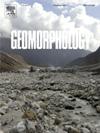利用遥感和冰川模型揭示了喜马拉雅中部冰川涌动的机制
IF 3.1
2区 地球科学
Q2 GEOGRAPHY, PHYSICAL
引用次数: 0
摘要
冰川涌流是各种冰川灾害的主要诱因,包括冰崩、冰川崩塌和冰湖溃决洪水。本研究利用高时间分辨率遥感数据和冰川模型,系统地考察了喜马拉雅中部一座未命名冰川的特征和冰下过程。我们确定了一个始于2019年并持续不到8个月的激增事件,其特征是快速加速和减速阶段。在涌浪期间,0.23 km3的冰从高海拔转移到低海拔,导致冰川末端厚度增加超过70 m,推进超过800 m。与涌浪前的情况相比,在更大的表面积上形成了广泛的裂缝。我们的分析定量地描述了基础应力、应变速率和滑动速度的变化,揭示了这种激增主要是由地表融水渗透促进的冰下滑动驱动的。区域气候波动作为外部驱动因素,破坏了冰川的动态平衡,引发了冰川的涌流,而冰川的涌流受水文开关机制控制。本文章由计算机程序翻译,如有差异,请以英文原文为准。
Mechanisms of glacier surges in the Central Himalayas uncovered using remote sensing and glacier modelling
Glacier surges are a primary trigger for various glacial hazards, including ice avalanches, glacier collapses, and glacial lake outburst floods. This study systematically examines the characteristics and subglacial processes of an unnamed glacier in the central Himalayas, leveraging high temporal resolution remote sensing data and glacier modelling. We identify a surge event that began in 2019 and persisted for less than eight month, marked by rapid acceleration and deceleration phases. During the surge, >0.23 km3 of ice was transferred from higher to lower elevations, resulting in a thickness increase exceeding 70 m at the glacier terminus and an advance of over 800 m. This was accompanied by extensive crevasse formation across a larger surface area compared to pre-surge conditions. Our analysis quantitatively characterizes changes in basal stresses, strain rates, and sliding velocities, revealing that the surge was predominantly driven by subglacial sliding facilitated by surface meltwater infiltration. Regional climate fluctuations acted as external drivers, disrupting the glacier's dynamic equilibrium and triggering the surge, which was governed by a hydrological switch mechanism.
求助全文
通过发布文献求助,成功后即可免费获取论文全文。
去求助
来源期刊

Geomorphology
地学-地球科学综合
CiteScore
8.00
自引率
10.30%
发文量
309
审稿时长
3.4 months
期刊介绍:
Our journal''s scope includes geomorphic themes of: tectonics and regional structure; glacial processes and landforms; fluvial sequences, Quaternary environmental change and dating; fluvial processes and landforms; mass movement, slopes and periglacial processes; hillslopes and soil erosion; weathering, karst and soils; aeolian processes and landforms, coastal dunes and arid environments; coastal and marine processes, estuaries and lakes; modelling, theoretical and quantitative geomorphology; DEM, GIS and remote sensing methods and applications; hazards, applied and planetary geomorphology; and volcanics.
 求助内容:
求助内容: 应助结果提醒方式:
应助结果提醒方式:


